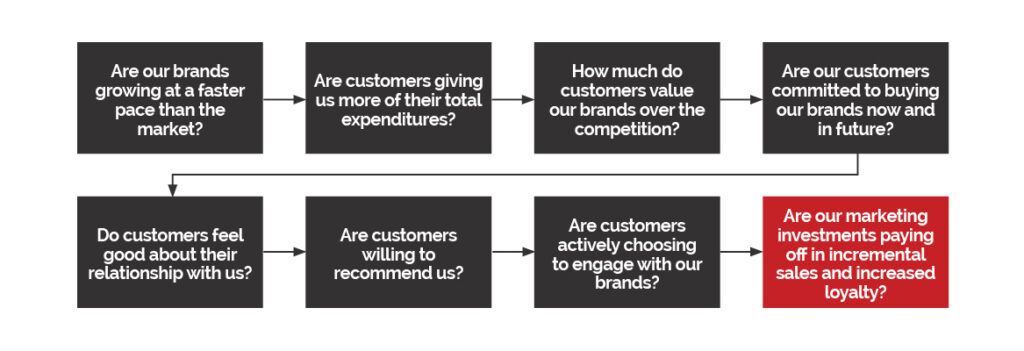The Only Number That Matters
Proving the value of marketing means showing that the investment is paying off in faster business growth. But that is only possible if marketing adopts a more unified approach to measurement.

It is the one number a CMO needs to know. The one number that truly matters. The one number that will appease the CEO.
Most CMOs wilt under budget interrogation by their boss. Because all CEOs ever really want to know is, “How much did you contribute to the growth of the business?”. Since CMOs never have actual hard proof to share, they throw up a smokescreen of soft metrics that have no obvious bearing on the health of the business. The invariable response: “So what?”.
No wonder CEOs lack faith in the financial literacy of marketers. They are exasperated at marketing’s perpetual failure to quantify the business impact of their spending. CEOs are judged on the corporate earnings trajectory – on whether they’re making their quarterly numbers – and on the stock price. And so, the only number a CEO cares to hear is the incremental growth rate attributable to marketing. The rest is mumbo jumbo.
Marketing is handed a slice of the operating budget to lead the charge on revenue growth: to help the business grow faster than it might otherwise – faster than competitors, faster than business analysts are projecting, and certainly faster than shareholders expect. The CEO needs the reassurance of knowing that money is being invested wisely – that it is building growth momentum – that it is generating a payback – if not next quarter, when? Is marketing driving sales that are truly above baseline? Do the profits on those sales exceed the fixed and variable marketing costs? Is the budget as lean as it can be?
That’s where the numbers get speculative.
Incrementality is hard to prove. Today’s meandering path to purchase makes it tough to trace a direct line between marketing expenditures and top-line sales, never mind knowing the ratio of customers who would likely have bought anyway. It takes disciplined experimental design to figure out. Even trickier is connecting the dots between brand value and enterprise value. And while there are plenty of brand tracking studies and academic research models showing how much a strong brand is worth, the corporate finance world buries that calculation under the label of “goodwill” along with other intangible assets like patents and trademarks.
In trying to win greater C-level credibility, marketers are faced with twin hurdles: the difficulty of converting intangible performance measures into hard financial numbers that are accepted as valid entries on the balance sheet; and a cultural discomfort with the language of business which is finance. Their mortal enemy remains the CFO who takes pleasure in the look of anxiety on their face at budget time.
That is why marketing is still viewed as a cost centre. It is why CMOs are easy scapegoats when the business fails to hit its financial goals (“Grow or Go”, they’re told). That is why most CMOs are still not welcome in the boardroom where marketing is an afterthought. And it why they are almost never asked to help develop the corporate growth strategy, just be answerable to it.
Yet marketers have more ways than ever to measure success – so why so little success at measurement? Mainly because the evidence is hard to gather. The proof points are scattered across various marketing, CRM, E-commerce, and business reporting systems, as well as external syndicated databases. And marketers tend to operate in channel and product siloes, squabbling over budget dollars, claiming their metrics matter the most. There is no shared stake in mutual success – nor even a collective understanding of what it means – each team favouring its own narrow interpretation.
Before marketers can showcase their contribution to business growth, they need to build a more unified measurement system – one that makes it easier to make the connection between brand building efforts and revenue – between relationship marketing and repeat purchase – between the total marketing investment and the one number that really counts: the growth velocity of the business.
A Marketing Metrics System
Any metric worth tracking is being captured and stored today on a system of some kind. The challenge is to fit those metrics into a united and cohesive framework where the interdependencies become more obvious. “Marketing managers need measures to assess the health of their brands and to judge the effects of their marketing campaigns. Sales revenue and contribution to profit … aren’t enough”, notes Bryon Sharp, the Professor of Marketing Science at the Ehrenberg-Bass Institute, best known for his muckraking book How Brands Grow1. “A thorough metrics system incudes financial metrics, buyer behaviour metrics, memory metrics, customer profile metrics and marketing activity metrics.”
With a glut of response and clickstream data available, it is easy for marketers to fall into the trap of obsessing over activity metrics.
With a glut of response and clickstream data available, it is easy for marketers to fall into the trap of obsessing over activity metrics. Knowing the number of brand followers and social media “likes” can be comforting – it proves that marketing tactics are having some influence on people – but whether or not they lead to stronger purchase intent remains a leap of faith.
Another trap is relying strictly on what customers have done in the past to predict the future. Revenue projections are usually based on an extrapolation of purchase trends while accounting for exceptional market events (say, a new product introduction) and exogenous factors (such as the state of the economy). But there are certain lead indicators that should be considered as well, such as people’s perception of the brand. Otherwise, marketers can be caught by surprise when sales plummet due to a precipitous decline in brand affinity (Kraft Heinz is a notorious case in point, forced to swallow a $15 billion write-down in 2019 on its most famous brands due to marketing cost-cutting that badly eroded their market value).
Using both attitudinal and behavioral metrics as parameters, marketers need to be able to estimate the potential lift in short and long-term brand sales based on different investment scenarios. To drive immediate revenue growth, for example, it may be smarter to free up some of the budget dedicated to brand image advertising in favour of doting on high value customers already predisposed to buy.
Marketers need an investment mindset to make those choices – not based on the immediate gratification of a spike in ad impressions and clickthroughs – but by positively affecting downstream measures of success like repeat purchase rate, average order value, and customer retention. Although few CMOs keep their jobs for long by looking too far out into the future – the next quarterly earnings report is about as far as many dare to go – there is little to be gained by stoking short-term promotional sales at the expense of sustainable long-term growth. Yet marketers are constantly under pressure to cannibalize future sales through aggressive discounting which only trains shoppers to stock up when sales events are held.
The first step must be to reach agreement on a marketing measurement model that shows the full chain of marketing effects. Gartner Research’s advice2: “Let go of activity-based-only metrics, like click-through rate or traffic, and embrace metrics that link marketing performance to business outcomes.”
At the top of the measurement hierarchy are the stepping stones of revenue growth – such as market share, category penetration and share of expenditures – which everyone recognizes as vital to success. The secondary tier is made up of the underlying brand and customer health measures that best explain market performance. Laddering up to those higher order tiers are the operational layers that show the impact of marketing investments, whether that is customer engagement across touchpoints (e.g., web, mobile, email, social); program results (e.g., brand building, demand generation, lifecycle management); and media effectiveness (e.g., online versus offline).
What is really critical to know are the interdependencies between different levels of the hierarchy. Marketers need to determine how movement at one level corresponds with another; which metrics are tightly associated; and the statistical strength of those dependencies. As McKinsey Consulting observes3, “Only when marketers have linked KPIs can they identify the interactions most tightly tied to business value and start making smart decisions to adjust or rebalance their marketing spend”.

To prove its contribution to business success, marketing needs a unified measurement system that links the chain of performance metrics to financial goals and outcomes.
Brand Health
The traditional role of marketing is to serve as the brand steward, responsible for growing brand equity through market positioning and messaging. But the concept of brand equity is an abstraction lost on most CEOs. Defined as the perceived value of the brand by the target market, it only ever gets acknowledged if a business is acquired, when it gets baked into the purchase price. Other than that, brand equity goes unrecognized as a business asset. And so, any proposed expenditures to build brand equity are viewed skeptically by corporate finance as a dubious investment since the asset value is fixed.
Brand equity may be dismissed by finance as a made-up marketing measure, but a healthy brand is certainly worth a fortune
Brand equity may be dismissed by finance as a made-up marketing measure, but a healthy brand is certainly worth a fortune (in 2021, Coca-Cola’s brand was valued at a whopping US$88 billion). If people strongly prefer the brand over the competition it will command a price premium because they are willing to pay more for it (Apple is the classic example – but it applies to any brand where price is not a primary choice determinant). People will go out of their way to buy it. They will be resistant to switching offers. They will be more open to expanding their relationship with that brand by buying more of what it has to offer. And they will be more inclined to recommend the brand to family and friends. None of that should be up for debate – yet finance brushes all of that off as too subjective.
For a brand to reach that coveted status it has to earn it. That means people have to be aware the brand exists – it has to be top-of-mind when they are ready to buy – it has to be seen as distinctive – it has to be admired for the experience it offers – and today, increasingly, it has to strike an emotional chord with its fans who will enthusiastically serve as advocates. Emotion is a tiebreaker. Feelings matter much more in decision making than we like to believe. A Tesla buyer feels pride of ownership – a Sephora member feels pampered – a Disney visitor feels joy – an Apple buyer feels superior. What a brand needs to avoid is being stuck in purgatory where customers feel nothing.
What needs to be proven is the correlation between those feelings and sales. If the determinants of brand health can be isolated and weighted according to their relative contribution (say, the importance of brand salience versus brand loyalty), they can be compared to market metrics. From that analysis a composite brand health score can be derived and tracked against revenue growth.
Even with a precise understanding of the link between brand health and market metrics, it can still be difficult to attach a hard number to brand value on the balance sheet. Neil Bendle, Chairman of the Marketing Accountability Standards Board (MASB), says, “Financial statements cannot fairly represent the value of the enterprise if they don’t systematically include key intangibles like the brand and customer relationships. Brand valuation has been a hodgepodge of rules inconsistently applied and reported.”4 According to MASB, brand value contributes almost 20% of enterprise value on average, even more for consumer brands. The onus is on marketing to come up with a way to prove the asset value of the brand using a sanctioned formula that reflects its current market strength and growth potential.
MASB has come up with what it declares to be a mathematically sound way to valuate a brand for investors. Its approach is to estimate the present value of future cash flow attributable to the brand based on a number of variables, including the size, growth rate and maturity of the category it competes in; the current level of consumer brand preference; the degree of price sensitivity; and its availability through distribution channels. A cash flow estimate is calculated for a defined time horizon (based on the expected life of the brand) and then a discount rate is applied to come up with a present value.
Customer Health
If that formula seems vaguely familiar, it is because much the same method is used to calculate customer equity, a term even more incomprehensible to a CEO, despite the fact it has been part of the marketing lexicon for more than a quarter century, longer if you go back to a time when continuity publishing and mail order cataloguing were flourishing5.
Based on the belief that a customer should be treated as an asset, it is calculated by estimating the total future net profit that can be expected over the average lifetime of a customer relationship. Customer equity is therefore the sum of the estimated future net value of all customers (even though the strict definition of equity requires liabilities to be subtracted).
Knowing what causes disloyalty can be just as important as knowing what keeps customers loyal.
The concept of customer equity has always been widely promoted as an economic justification for relationship marketing (Peppers and Rogers called it “Return on Customer”6): customers are bound to increase in value over time, the argument goes, provided they are treated with respect. Yet the concept has never gained much traction in corporate finance despite the irrefutable logic: the greater the number of happy customers, the more successful a business will be in the long run. But financial accountants are oblivious to the number of customers and could care less how happy they are or what they may be worth in future.
Unless a business is a pure startup, the next sale is likely to come from a current customer. And the more loyal customers are to the brand, the more likely they are to buy additional products and services. That is why the Pareto principle is true of most businesses: a small minority of loyal heavy spenders usually account for a disproportionate share of profits and are usually five times more valuable than an average customer. Those are also the customers willing to refer the brand to other people, a calculation that Bain’s Fred Reichheld argues should be a key part of the equation. He calls it “earned growth rate”: the revenue growth generated by existing customers and the referrals they bring in.
Naturally, a business cannot simply rely on organic growth to sustain itself – after all, some attrition is unavoidable. Lost customers need to be replaced. And marketing is always faced with stretch growth targets, when they must win over a greater share of new market entrants; capitalize on emerging market opportunities; and crack open promising adjacent markets. This is where customer lifetime value can be helpful: guiding the level of investment in new growth by setting a ceiling on acquisition spending. And marketing can use what it knows about customer profitability to identify the ideal market segments to go after. A rule of thumb is to set the allowable acquisition cost at a ratio to LTV of 3:1. That is, the cost should be fully recoverable within three years.
The main gauge of customer health is certainly loyalty. But loyalty is not necessarily synonymous with behavioural metrics like customer retention and repeat purchase rate. Customers may stick with a brand for many reasons – passivity, habitual buying, lack of alternatives, or simply convenience. Often, they feel totally ambivalent toward a brand and have no qualms about switching because they view the choices as completely substitutable (think telcos, grocers, banks, insurers).
A truly loyal customer is one who believes the brand is an integral part of their life: they could not live without it – they would go out of their way to buy it – they would never consider switching – they would mourn its demise. Highly loyal customers only ever defect if they’re driven away by extreme negligence. Knowing what causes disloyalty can be just as important as knowing what keeps customers loyal.
The most widely used loyalty measurement equation today is certainly the Net Promoter System which appears on the enterprise dashboard of most top firms as a benchmark measure. The NPS score represents the ratio of “net promoters” willing to recommend the brand. It is used as both a barometer of how customers feel about the brand relationship, as well as how they rate specific sales and service “moments of truth”.
There is risk in relying on NPS as the sole loyalty metric – after all, people may recommend a brand even if they are one-time users – and some view it as much too simplistic, preferring to augment it with a medley of diagnostic metrics. For example, knowing whether a customer intends to buy again – or is likely to try competitive products – or perceives the buyer journey to be worth the trouble – can reveal the true depth of commitment to the brand.
Drawing an accurate picture of the health of the customer portfolio means tracking both the behavioural indicators – like purchase frequency, average annual spending, and “share of wallet” – and emotional drivers such as brand relatability, trustworthiness, and empathy (the perception that a brand actually cares enough to put customers first).
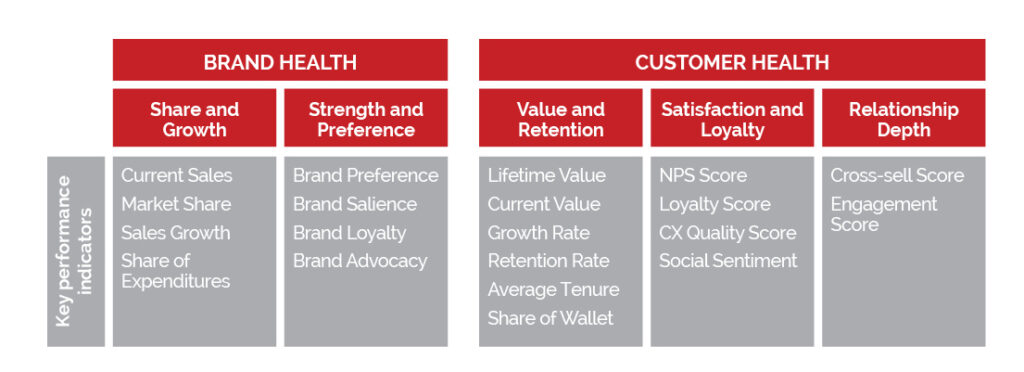
Marketers need to understand the interdependency between value measures and the underlying attitudinal drivers of brand and customer health.
Program Measurement
If loyalty is the principal fulcrum used by marketing to drive growth in customer value, the question is what will it take to move customers up the loyalty ladder? To get them to spend more, more often. To love the brand. To become brand advocates.
The surest path to business growth is to make the brand an integral part of as many people’s lives as possible, delivering value at every stage of the customer lifecycle, from the time they first encounter the brand to continuous engagement as the relationship progresses. Marketers must be able to track movement through each stage of the lifecycle using progression metrics, such as the lead-to-sale conversion ratio; the average interval between purchases; the spend level and activity of customers by time period; the year-over-year change in average annual spending based on tenure; just to cite a few common ways.
The surest path to business growth is to make the brand an integral part of as many people’s lives as possible, delivering value at every stage of the customer lifecycle
Making smart investment decisions demands a funding formula that equitably supports both acquisition activity (like advertising and lead generation) and loyalty building. Here again the LTV calculation comes in handy. What is the residual CLV value of all current customers? How much can we expect them to contribute to profit during the current earnings period? The next fiscal year? What is the cost of attrition expressed in lost opportunity? What is the replacement cost? How much room for deeper category penetration is there? Is the cost of converting competitive brand users worth it?
Another major role of marketing is keeping customers continuously engaged as the relationship matures. The strongest sign of a healthy relationship is the reciprocal exchange of information. As the relationship grows stronger, a customer becomes more confident in sharing details about their personal interests and needs, trusting the information will be put to good use. So, a key indicator of success is not just the size and addressability of the consenting audience, who have proactively agreed to stay connected and involved in some way, but the willingness of customers to provide personal data and feedback that can improve their experience. A blended engagement score can capture that customer dynamic.
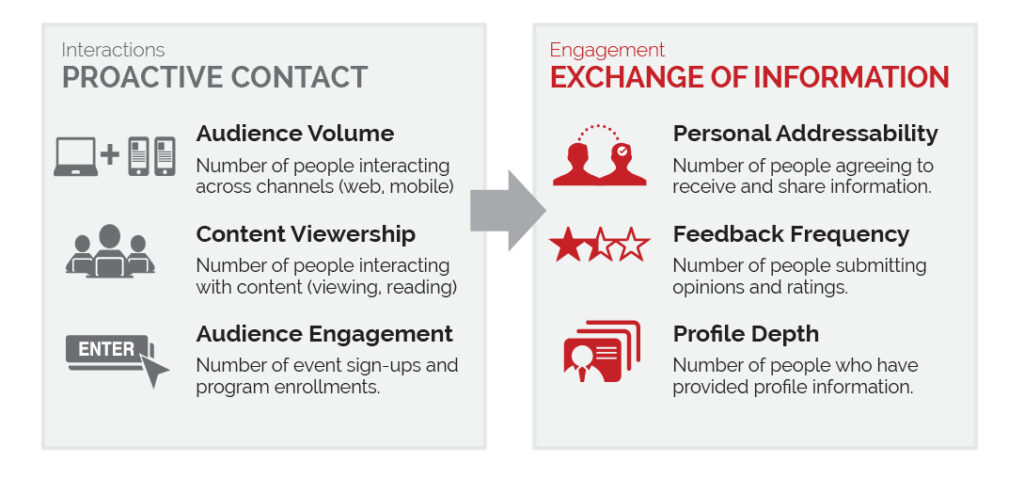
The components of an engagement score should include measures of both proactive contact and the consensual exchange of personal information.
Today most marketing programs are designed to drive engagement. These programs need to build brand awareness – encourage discovery and exploration of the brand – support post-sales interactions – make “next best offer” recommendations – and reward the best customers with special treatment and entitlements. To know if those investments are paying off, marketers need a wide range of success metrics that show whether they are achieving their tactical objectives.
Each marketing program will have its own set of key performance indicators. A program designed to educate and inform customers on brand-related topics is evaluated according to content marketing metrics. A loyalty program is focused on optimizing membership metrics like enrollments, activations, point accruals, redemptions, and “lift and shift” in member spending. A voice of customer program is seeking to maximize survey and polling responses while building as participative a brand community as possible. A social media program is interested in attracting a large audience of engaged followers to maximize social sharing. And a demand generation program is of course tracking the full range of performance metrics, from digital ad impressions to video viewership to landing page visits to trial sign-ups to sales conversions.
Marketers must also consider the efficacy of different media channels. How much of the engagement traffic is flowing through the corporate website? The content hub? Satellite sites? The mobile app? Social channels? What is the halo effect of offline media? This is the efficiency question – perhaps the toughest one to answer, simply because people are using multiple channels and devices, often simultaneously. What is the impact of an outdoor billboard ad or a TV commercial or a print ad? Digital metrics like surges in web traffic and app downloads – in search engine results – in the clickthrough rate – offers some clues. But channel optimisation really demands more advanced analysis like market mix modeling and multi-touch attribution methods, using commercial tools and media tracking services.
Unified Measurement
All of these disparate measures – from attitudinal to behavioural, from survey-based to transactional, from raw numbers to derived calculations, from aggregated counts to derived scores – need to be corralled and herded into a unified measurement system where they can be tracked, visualized, and explored.
A multi-dimensional dashboard should serve as an “at a glance” portal to the marketing metrics system, featuring the capability to track metrics versus goals; compare multiple time periods; highlight deviations from plan; trigger exception alerts; support drill-downs to underlying segments, cohorts, products, and regions; and conduct “what if” simulation planning.
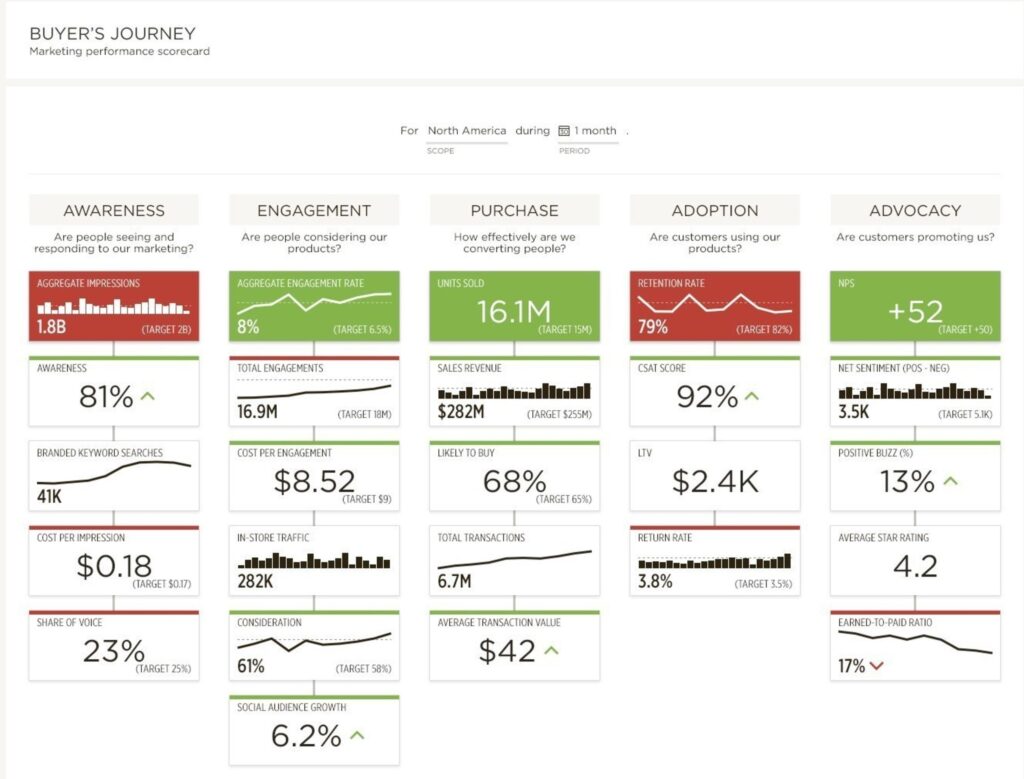
A Marketing Dashboard can serve as a unified repository of key metrics offering an “at a glance” view in the form of infographics. Source: Ignite Tech
It should also be possible to visualize the sales history with yearly trend lines that can be mapped back to the timing and amount of different program expenditures. With enough history, the evidence will begin to mount showing exactly how those investments are paying off in annual business growth.
With the entire universe of marketing measures in one central repository, strategic insights can be gleaned through econometric analysis, determining the correlative strength between a dependent variable (such as sales volume) and multiple independent variables (like brand and customer health scores). The influence of each variable can be quantified and used to rank the business impact of the different performance drivers. The value of a one-point increase in loyalty or brand preference can be calculated and used to figure out the level of effort and expense required to achieve it.
Eventually a direct line can be drawn showing the full chain of effects – from marketing investments to market metrics to business results to financial payoff. Ideally, the unified measurement system will lay the groundwork for concluding whether the overall investment in marketing – the total marketing budget – is appropriate based on a thorough bottom-up ROI analysis, proving that for this amount of money, the business can expect this rate of growth.
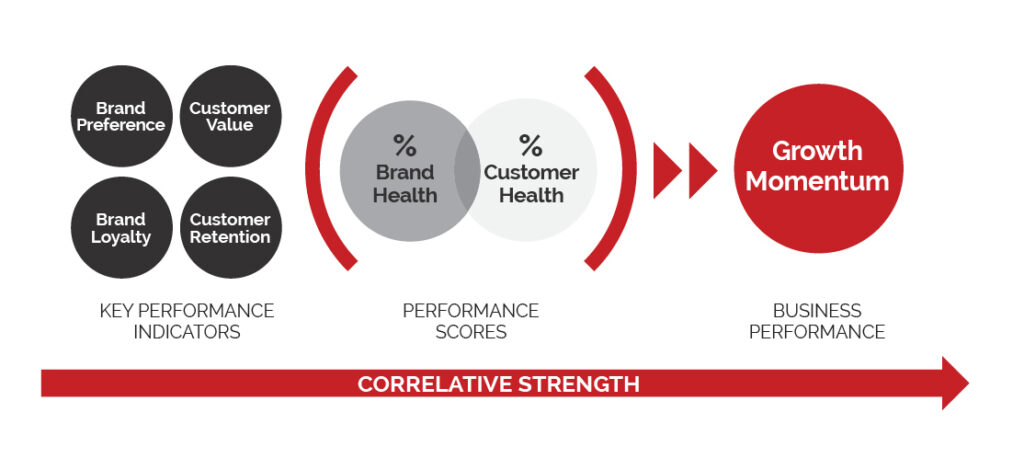
The central measurement challenge is to prove that marketing is making an incremental contribution to growth momentum.
Today most marketing budgets are a fixed expense, typically about 11% of the overall budget, and regularly subjected to quarterly trimming depending on how sales are performing against target. The size of that budget is often dictated by what was spent the previous fiscal period and approval above that figure always requires some fancy tap dancing in front of the CFO. To escape this financial straight jacket, marketers need to convincingly link corporate growth ambitions to the mandatory investments required to achieve them. In the end, that means emphatically answering the most burning question on the mind of the CEO: Is marketing worth the expense?
1. Bryon Sharp’s main thesis is that brands can only grow by reaching everyone in the target market, even the ultra-light buyers in a category. He also argues that loyalty ladders are “misleading and unhelpful”.
2. McKinsey & Company, “Why Every Business Needs a Full-Funnel Marketing Strategy” (February 2021)
3. Gartner Research, “How to Prove the Value of Marketing to the Enterprise” (December 2019)
4. “Proving the Value of a Brand”, MASB/Forbes (2019)
5. Most of the early credit goes to Robert C. Blattberg and John Deighton who published a popular article in Harvard Business Review called “Manage Marketing by the Customer Equity Test” (1996).
6. “Return on Customer”, Don Peppers and Martha Rogers (2005).
Stephen Shaw is the chief strategy officer of Kenna, a marketing solutions provider specializing in delivering more unified customer experiences. He is also the host of a monthly podcast called Customer First Thinking. Stephen can be reached via e-mail at sshaw@kenna.
